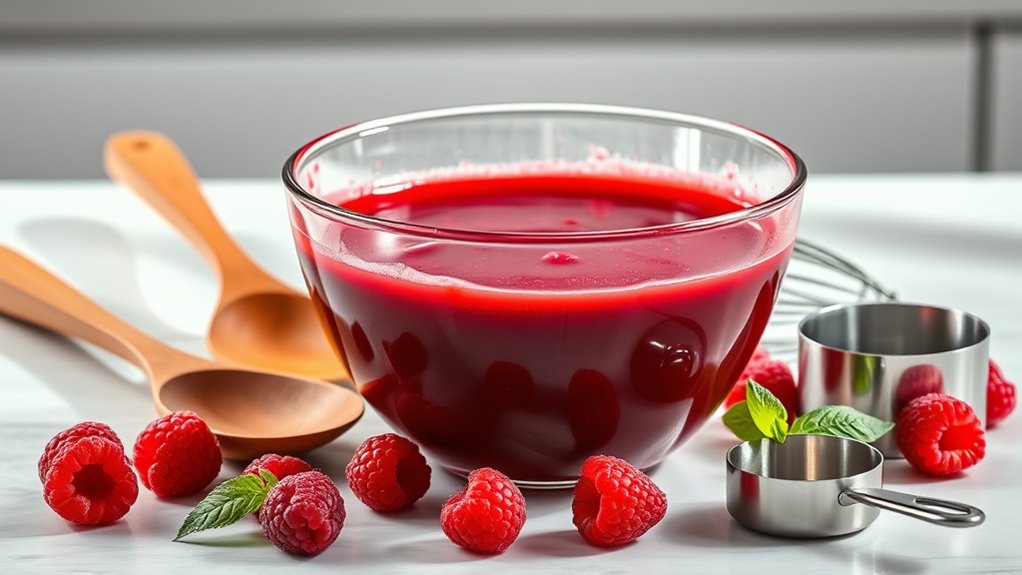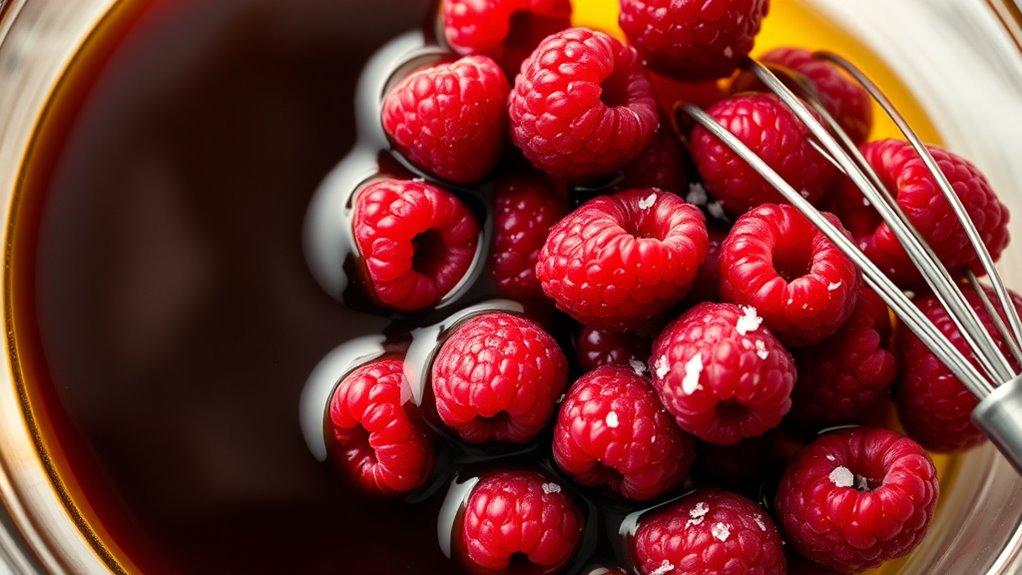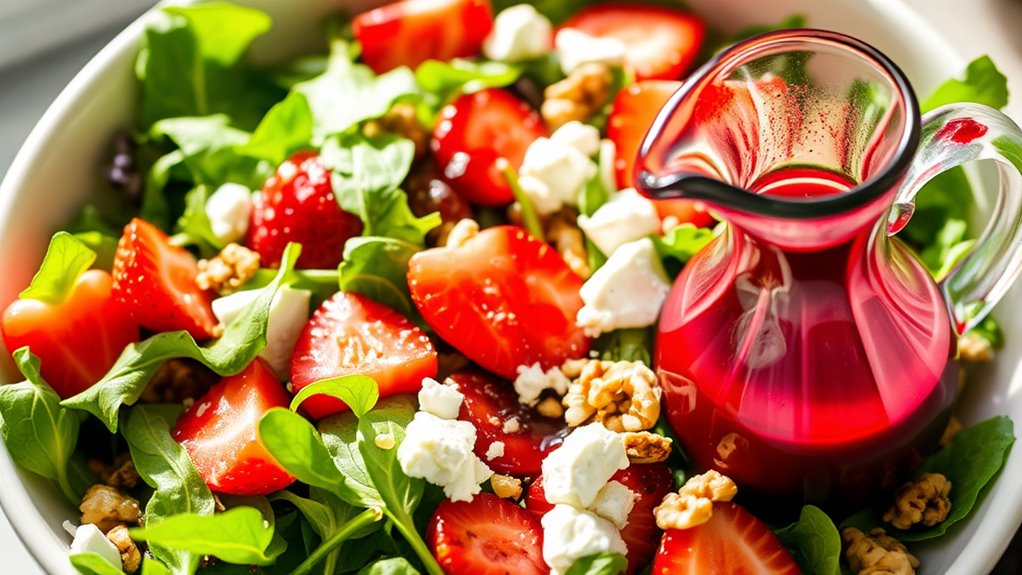To make a bright Raspberry Balsamic Salad Dressing, start by lightly mashing fresh raspberries to release juice, then whisk together balsamic vinegar, honey, Dijon mustard, and a pinch of salt. Gradually whisk in olive oil to form a smooth emulsion, adjusting sweetness or acidity to taste. Chill briefly if it separates, then re-emulsify. This dressing pairs beautifully with greens like arugula or spinach, and you can add walnuts or cheese for texture. Continue for more tips and variations.
Ingredients and Quantity

The ingredients for Raspberry Balsamic Salad Dressing are simple and pantry-friendly: you’ll need 3 tablespoons of balsamic vinegar, 2 tablespoons of extra-virgin olive oil, 1 tablespoon of honey, 1/2 teaspoon of Dijon mustard, 1/4 cup of fresh raspberries (slightly mashed), a pinch of salt, and a pinch of black pepper. You’ll sense raspberry flavor and balsamic vinegar guiding balance, so measure precisely. This list supports clear, evidence-based prep: fewer variables mean reproducible results and freedom to explore tweaks.
| Ingredient | Purpose |
|---|---|
| Balsamic vinegar | Acidity and depth |
| Fresh raspberries | Flavor and brightness |
| Olive oil | Emulsion base |
| Honey + mustard | Sweetness and emulsifier |
| Salt/pepper | Seasoning |
Preparations

To prepare the dressing, start by mashing the raspberries lightly in a small bowl to release their juice without turning them into puree. whisk the balsamic vinegar, honey, Dijon mustard, and a pinch of salt together until smooth, then slowly whisk in the olive oil to form a stable emulsion. In practice, portion control matters: measure ingredients precisely and add oil gradually to maintain consistency. For dressing techniques, keep the mixture chilled briefly if separation occurs, then re-emulsify with a few vigorous whisk strokes. When ready to serve, taste and adjust sweetness or acidity with honey or vinegar as needed. This approach supports salad preparation that is reliable, repeatable, and flavorful, aligning with clear, evidence-based guidance for a freedom-loving cook.
Kitchen tools or Kitchenware Required

A basic set of tools will streamline the raspberry balsamic dressing, including a small mixing bowl, a whisk, and a measuring spoon or scale for precise ingredient amounts; you’ll also want a spoon or spatula for mashing berries and a container with a lid if you opt to store leftovers.
Table: Kitchen Tools
| Tool Type | Purpose | Notes |
|---|---|---|
| Salad mixers | Emulsify vinaigrette | Use for even blending |
| Measuring cups | Quantify liquids | Prefer metric for precision |
| Spatula | Transfer and mash berries | Easy scraping |
Choosing reliable Salad mixers and Measuring cups helps guarantee consistent results, minimizes waste, and supports a flexible cooking approach. Freedom thrives when your tools serve clarity, accuracy, and speed.
How to Cook

- Gather all ingredients and tools: raspberries, balsamic vinegar, olive oil, honey, salt, pepper, whisk, and bowl.
- Whisk together raspberries, balsamic vinegar, olive oil, honey, salt, and pepper until smooth.
- Use a steady, controlled motion to emulsify the oil without splashing, ensuring a cohesive texture.
- Taste the dressing and adjust sweetness or acidity as needed to balance flavor.
- If a thicker consistency is desired, blend longer or add a touch of Dijon mustard to aid emulsification.
- Allow the dressing to rest for a few minutes to let the flavors meld.
- Avoid overprocessing to prevent over-thickening.
- Store any leftovers in the refrigerator and shake well before using.
- Note: No heat is required to preserve the fresh fruit flavor and antioxidant content.
How to Serve

When serving, drizzle the Raspberry Balsamic Salad Dressing over a mixed green salad just before serving to preserve the dressing’s vibrant color and emulsified texture. You’ll want to balance portions so greens remain crisp and flavors stay bright. Pair with arugula, chicory, or baby spinach for peppery notes that echo the raspberry balsamic profile. For serving suggestions, add sliced strawberries, walnuts, and feta or goat cheese to create contrasting textures and a cohesive flavor arc. Dress lightly, then toss gently to avoid wilting. Consider a small pitcher on the side to control distribution and prevent over-dressing. This approach supports confident salad pairing decisions and emphasizes freshness, texture, and flavor clarity in each bite.
Tips
To maximize flavor and texture, start with a raspberry balsamic that’s balanced and fresh; this makes it easier to dress greens evenly without overloading any one bite. You’ll gain control over flavor by adjusting sweetness, acidity, and intensity with simple tweaks.
- flavor enhancement: add a splash of orange juice or a pinch of salt to heighten brightness without masking raspberry notes.
- dressing variations: experiment with olive oil ratios, swap balsamic for red wine vinegar, or include a touch of Dijon for structure.
- texture tweaks: whisk vigorously or blend briefly for silkiness; drizzle slowly to prevent pooling on leaves and to maintain coat.
Food Value and Benefit
This raspberry balsamic dressing offers a flavorful way to boost your meal’s nutritional profile. Made from wholesome ingredients, it provides essential vitamins, minerals, and beneficial compounds that support overall health.
Food Value of Prepared Dish:
- Rich in dietary fiber from raspberries
- Contains vitamin C, manganese, and antioxidants
- Provides heart-healthy monounsaturated fats from olive oil
- Includes small amounts of vitamins E and K
- Contains minerals such as potassium and magnesium
- Low in calories with minimal glycemic impact from balsamic vinegar and natural sweeteners
Benefits of Eating This Recipe:
- Supports immune function and skin health due to vitamin C and antioxidants
- Promotes heart health through healthy fats in olive oil
- Helps maintain steady blood sugar levels with low-glycemic ingredients
- Enhances digestion and gut health thanks to dietary fiber
- Increases micronutrient absorption when paired with greens and vegetables
- Aids in weight management by promoting satiety and nutrient density
- Provides a natural, flavorful alternative to high-calorie dressings, supporting long-term wellness without sacrificing taste
Incorporating this raspberry balsamic dressing into your meals is a simple, practical way to enjoy nutrient-rich foods while enhancing flavor and health benefits.
Frequently Asked Questions
How Long Does Raspberry Balsamic Dressing Last in the Fridge?
Raspberry storage lasts about 1 week in the fridge when kept refrigerated in a tight container. Dressing shelf life can extend slightly with lemon juice or vinegar, but use within seven days for best flavor and safety.
Can I Substitute Honey for Sugar in This Recipe?
Yes, you can substitute honey for sugar. Start with equal sweetness, then adjust to taste; consider honey alternatives and sugar substitutes like maple or agave if needed. Keep texture and balance by tasting as you go.
Is This Dressing Suitable for Vegan Diets?
Yes, this dressing can be vegan if you use vegan ingredients like maple syrup or agave instead of honey and guarantee no dairy. For dressing alternatives, check vegan ingredients lists and adjust sweetness to taste with confidence.
Can I Freeze the Dressing for Later Use?
Yes, you can freeze it. Freeze in a freezer-safe container, leaving headspace, and thaw in the fridge. About 70% of home freezers avoid freezer burn with proper dressing storage; use freezing methods to preserve texture and flavor.
What Pairs Best With This Dressing Besides Salads?
You can pair this dressing with grilled chicken, roasted vegetables, cheese platters, and fresh fruits; it complements them by balancing acidity and sweetness, offering a versatile, evidence-based flavor profile that supports mindful, freedom-filled dining decisions.
